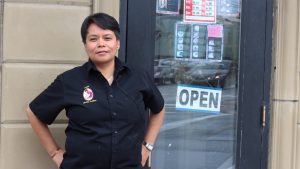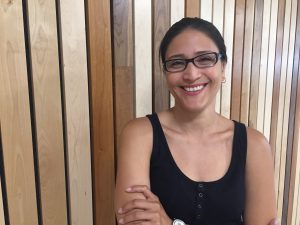After 30 years in Canada, a woman from Guatemala sticks to her roots by sharing the flavors of the Latin cuisine.

With a diploma of International business by NSCC, accounting studies at Dalhousie University and more than 25 years of cooking experience, Claudia Pinto is the chef and owner of Café Aroma Latino, a café that offers a mix of Latin American dishes and a small grocery store specialized on Latin American products.
“Before I open the cafe. I travelled almost all Latin America trying to find the staple of that specific country to be able to come here and cook as authentic as I can.” Pinto says.
Surrounded by colonial furniture, Guatemalan pottery, Latin American crafts and the aromas of her spices, Pinto runs her business located on the corner of North Street and Agricola Street in the North End of Halifax.
“I love this part of the city. People here is friendly, easy going, patient and honest.” Pinto says.
The area has a very diverse range of businesses. From restaurants and bars to start-up companies, beauty-wellness businesses and many more.
According to Patty Cuttel-Busby, Executive Director of the North End Business Association, there’s about 400 business in the zone encompassed by Agricola Street, Gottingen Street, Cogswell Street and Young Street.
Café Aroma Latino is one of them. Since the business started almost 9 years ago, it has always been located in the same spot.
“One thing most of the businesses in the area have in common is that the majority of them are small-locally owned business. I think that is very important and what distinguishes the North end from many other places.” Says Cuttel-Busby.
As reported in the latest data by statistics Canada, there are 1,259,812 business in the country by June, 2017, 2.5 per cent of those business are located in Nova Scotia.
According to an analysis of Statistics Canada’s total business counts in Nova Scotia by employment size in June 2017, there are 31,255 businesses in the province. Out of that number 73.9 per cent have an employment size between one to nine employees and 54 per cent of the total number of business in the province have between one and four employees. The numbers are practically the same compared with the same period of time in 2016.
Pinto’s business reflects that trend. Back in 2008 when she opened Café Aroma Latino, she started with three employees plus herself. Now after nine years, she is the only one.
From cooking, serving, book keeping, cleaning, purchasing and cleaning, Claudia Pinto does it all. She sometimes has somebody to help her, but not every day.
But this is not the first time Pinto owns a business. Her passion for her culture made her start Tenango Imports back in 1997, a business of traditional Guatemalan crafts, clothing and colonial furniture.
The business wasn’t profitable. After two years of trying, Pinto decided to close it down.
After that experience Pinto had several different jobs but the dream of sharing her culture remained alive.
It was until studying international business at NSCC when Pinto wrote the business plan for Café Aroma Latino, combining her passion for cooking and sharing her culture. After a few months she got a loan from Credit Union to make it happen.
Consolidating her business has been a long process. During almost four years Pinto had to work both in her business and at RBC bank in order to afford keeping Café Aroma Latino running.
“It’s been an enjoyable and stressful journey.” Pinto says. “But being one of the few restaurants focused on Latin food makes me proud, unique. Being able to share my culture with everybody is my happiness.”
Since 2014 she works and focuses only in her business, and even though she is not “making the big bucks” as she says, she doesn’t have the business for the money.
“As long as I have money to pay my bills and to travel to visit my father I am happy with that.” She says.
Pinto feels she reached her main goal when she opened her business, now she is focused in expanding her menu by creating new meals that reflect the flavour of Latin America.



